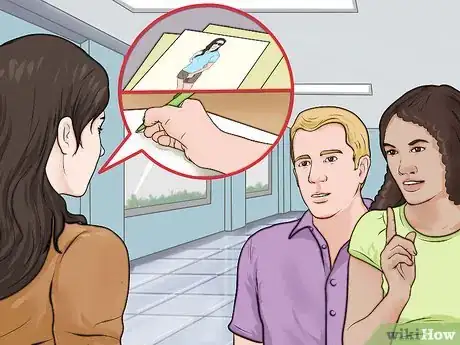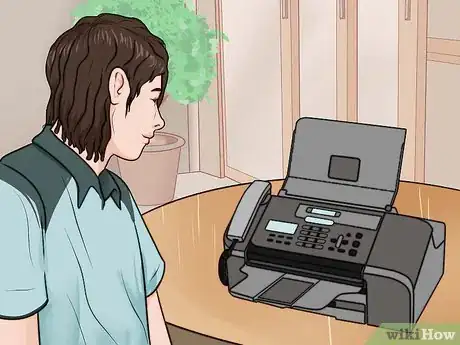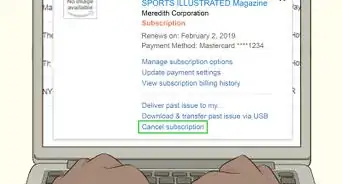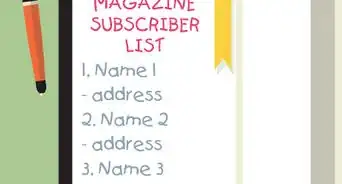This article was co-authored by Joe Simmons. Joe Simmons is a Corporate Trainer based in West Palm Beach, Florida. Joe specializes in operations management, leadership, learning and development, and employee training to help employees become high-performing teams. He holds a Bachelor’s degree in Marketing from The University of South Florida. Joe’s coaching has helped numerous organizations with employee retention, revenue growth, and team productivity.
wikiHow marks an article as reader-approved once it receives enough positive feedback. This article has 35 testimonials from our readers, earning it our reader-approved status.
This article has been viewed 517,017 times.
Have you spent your life dreaming of starting up your own magazine? Maybe you want to create a mag about your favorite activity (skateboarding? Shopping? Following celebrities?) or maybe you want to get information out into the world about an issue you are passionate about. Whatever your reason, this article will help you through the process of creating a magazine and running it successfully.
Steps
Building Your Publication
-
1Brainstorm concepts for your magazine. Before you start building your publishing empire, you need to create something. If you have not done so already, sit down with a trusted friend and start bouncing ideas off each other, and see what emerges. Ask questions like:
- What will be the topic of your magazine? Focus on things you love and know well, whether that is sports, fashion, computers, or social networking. Creating a magazine based on your passions will be more engaging, relevant, and useful to your readers than a topic you have no relationship with.
- Who is your target audience? This will help you focus on your possibilities. For example, if your topic is fashion, your demographic will have a huge impact on the style and substance of your magazine, as well as potential ad revenue. If your target market is teenage girls/boys, for example, you'll approach the writing, content, even the logo and color scheme much differently than you would if you were targeting men over 40, or gender-neutral 20-somethings. Determine the age, gender, income level, geographic location, and education level of your target audience.
- What caliber will your magazine be? As odd of a question as this may be, you will have to decide if you want your magazine to be an authority on a subject (like cooking or fashion) or if you want your magazine to be light, gossipy publication (think Ok! or Us.)
-
2Define your content. It will take time, effort, and money to get people interested in reading your magazine. Make sure you can keep them once they've started reading by reaching people who have a continuing need.
- For example, consider buying a home. There are three groups of people who could be reached with a magazine: the buyer, the seller, and the real estate agent. However, of those three groups, only one has the potential of being a repeat customer, and that's the real estate agent. Unless you target investment buyers and sellers—which is really a completely different market—your best target audience for repeat business will be the real estate agent.
- It is also important to keep the content simple. Complicated content can lose readers quickly, so make it digestible and easy to understand, tailored to what people are interested in and not wandering off its main topic.
Advertisement -
3Reach out to people who can help. To make any business venture a success, you need to interact with a broad range of people—people who will help make your magazine successful. Influential people in your market are very important to know and engage with.[1]
- For example, if you're creating a magazine for rock climbers, you will want to meet the top climbers, content creators, and other stars in that firmament. It may be that they do nothing more than tell their friends, "Hey, there's a rad new mag coming out in a couple months", or they may say, "Hey, there's a rad new mag coming out in a couple months, and I'd love to do a spread on your trip to Smith Rocks." Either way, you're a winner.
- Talk to people with experience starting and financing business ventures, and people in the printing industry. Talk to your banker, your attorney, printers, website creators--anybody who might have a wealth of knowledge and experience that touches your venture is good to know.
-
4Get to know your competition. Do your homework and find out what magazines already exist in the field that you want to cover. What makes these magazines successful? What do you think you could do better than them? Find something about your concept that would make your magazine stand out in the crowd.
-
5Create a business plan. This will help you define what you are going to do, and help you plan for the future. You will have to develop hard numbers for revenue, understand the competition, and codify your needs so that you will always know what you're doing—even when you don't!
- You will also need a business plan when you approach the people who will fund your venture. They're much more likely to invest in your venture when they see you've invested time and effort yourself.
- Consult a business plan consultant or writer who can help you to create a solid, cost-effective plan. While this will cost you money, it will ultimately save you money in the long run.
Building Your Team
-
1Build a team. Once you've gone through the process of defining your magazine and what group of people it will serve, you will want to put together a small team of people who can create that vision. If you began this project with a partner, even better. You might be tempted to think, "I can do it all, myself." Don't fall into this trap. Ask people who are as passionate about your subject as you are to join you on this adventure.[2]
- It takes a lot of time to write articles. It takes more time to photograph or source and edit images. It takes still more time to do the page layout, ad sales, manage the printing process, sales, distribution, and customer support. Each of those disciplines require their own levels of expertise. Unless you plan on publishing one copy every 6 months, it would be wise to build a staff at this point.
-
2Hire a management team.This is most likely your primary role, though you will undoubtedly be participating in the other roles as well. You'll oversee everything, do the books, look for funding, find printers, and more. However, on top of the stuff you do, you will also want to pick up managers to head the different parts of the publication process. These include:
- Publication manager. Somebody has got to be out there sourcing printing houses, paper costs, doing spot checks, proofing, and being the point person for everything to do with the nuts and bolts of publishing.
- Sales manager. All those ads have to come from somewhere, because that's where a lot of the revenue is going to come from—especially at first, as you give away copies as fast as you can. Having somebody working that revenue stream every day will make a huge difference on your bottom line.
- Marketing manager. Even if you build it, they're not going to come unless they know about it. A marketing manager will spread the word, get your magazine placed on newsstands, bookstores, distribution houses, and more. Your marketing manager will also know what the competition is doing—what's in their press kit, what promotions they're running, and how they're being successful—and then do it better!
-
3Hire the content creators and layout specialists. In the beginning, you might want to consider picking up freelance writers, editors and photographers. Freelancers will save you money as they are not full-time staff but still produce (mostly) high-caliber work. For the graphics side of things, you may want to consider hiring a design consulting firm who has experience working with magazine startups.
- Writing and editing. All those fine and witty words, the articles, even the page numbers and table of contents all need to be written and edited. Emphasis on editing.
- Graphic designer. What does the magazine look like? Again, different markets need different design approaches, and people will respond accordingly. Consider the difference between, for example, Wired and The New Yorker. Wired made their mark with day-glow colors, cutting edge page layout, and bold use of white space. It appealed to the geekdom like nothing else at the time. Now consider The New Yorker, with it's wry, pastel art, witty cartoons, and probing articles, all wrapped up in traditional fonts and page layout.
-
4Find a printer. You will only need a printer after you have actually created your first issue (see Part Three.) Before you decide on a printer who will be solely responsible for creating the first edition of your magazine, you should meet with several printers. Find out what they charge for a magazine like yours, what experience they have with magazine printing, etc.
- You should also see if you can find reviews for the publisher. If you find reviews like “All of the pages were diagonal and they still charged us!” run away as fast as you can.
Creating Your First Issue
-
1Plan your first issue. Come up with stories you want to cover--be they written or photo stories. Decide how many photo-only sections of the magazine you want to have (if any.) Even if you don’t have the content yet, you can still map out each page. Do mock-ups of the layout--use "lorem ipsum" text to fill in the empty spots (latin text that many publications use as placeholders for articles before the actual article is finished,) drop in pictures from the internet as picture placeholders—anything that lets you visualize and plan your first issue.[3]
- Armed with your mock-up, your writers and designers will know what to create, your marketing and sales people will know what to sell, and your publishing people will be able to start pricing things out and getting bids.
-
2Plan for future issues. While your staff is creating the content for the first issue, rough-plan the next 6 publications. It's easy to get started, but deadlines in the publishing industry come fast. If you're really prepared, you will have the second magazine ready to finish as soon as the first one is out the door. Always try to stay at least one month ahead of schedule.
-
3Create a catalog for articles and stories you can use in the future. Sometimes, you will have to cut stories because of space issues, content issues, relevance issues...the list goes on. That doesn’t mean those stories won’t be able to be used in the future.
- Maybe a freelance writer came across a story about a Christmas tree farm that inexplicably gets visited by a herd of wild reindeer every Christmas eve. But you are currently publishing your July issue. No worries--stick it in your ‘To Be Used’ article log and plan on running it in the December issue.
-
4Launch a website. As you're about to launch your magazine, put up a website. It doesn't have to be elaborate, at least not at first, but it will give people a place to see teasers to your publication and the content before they buy it. It'll also be a place where you can have an active community forum for feedback and commentary—invaluable if you want to grow into a successful publication.
- Set your website up so that some of the articles are open to public browsers, but others require a subscription to your magazine to be viewed.
-
5Build your magazine. Now that you have your team in place, the design firmed up, and content creators ready to create, make your first issue. You'll inevitably have kinks to work out, but the only way to know that is to do it. It'll be a process you'll never forget, but at the end, you'll have a magazine!
After Launching Your Magazine
-
1Pay attention to feedback (and be open to constructive criticism.) Your first issue will be an incredible learning experience, and a heavy moment, but that's just the beginning. When people start reading it, and advertisers see it in print, you'll undoubtedly get feedback. Pay attention to it.
- Do they love the content, but hate the layout? Find out why they hate it. It might be a perfect layout for a different demographic, but not yours. Before changing things willy-nilly, analyze the pros and cons.
- Is it priced right? People often complain about the price of things that they buy, but the key here is "did they buy?" If you get a lot of feedback saying, "It looked nice, but was too much, I didn't buy it", you might have to readjust your numbers. That could be just adjusting your expectations, or it might mean selling more ads instead of charging more per issue.
- Encourage staff feedback as well. Staff may have some great ideas that arise out of what they've learned while creating content or marketing the magazine.
-
2Keep track of what you're doing right. Promotions that work—keep them. Columns that got rave reviews—do more in that style. That little chatty throwaway section of witty comments about the field? They loved that? Feature it! The key is to pay attention and respond, both to what went wrong, and what went right.
-
3Continue fine tuning. Always keep track of the numbers, of what's working, and what isn't. Your market will change, the times will change, and whatever your topic is, will be subject to good times and bad times. Stay ahead of the game by knowing your chosen industry intimately, and you'll do great. Good luck!
Community Q&A
-
QuestionIs it better to start online or with a hard copy?
 Community AnswerIt actually depends on your target market. For example, if it is a magazine for millennials, you may want to start online and then as your customer base grows then you could expand into print. However, in most cases it may be best to start online first because it is a lower cost approach and it is more sustainable for the average person. Not too many people have the money or time to print, develop, distribute, and convince book stores and newspaper stands to carry the magazine developed.
Community AnswerIt actually depends on your target market. For example, if it is a magazine for millennials, you may want to start online and then as your customer base grows then you could expand into print. However, in most cases it may be best to start online first because it is a lower cost approach and it is more sustainable for the average person. Not too many people have the money or time to print, develop, distribute, and convince book stores and newspaper stands to carry the magazine developed. -
QuestionI need ideas on starting up a kid's magazine. Any tips?
 Community AnswerIt should be colorful and fun, with things like stickers or posters that kids can cut out. As far as themes, kids may enjoy comics, animals, super heroes, etc; basically anything you would find in a kid's TV show.
Community AnswerIt should be colorful and fun, with things like stickers or posters that kids can cut out. As far as themes, kids may enjoy comics, animals, super heroes, etc; basically anything you would find in a kid's TV show. -
QuestionWhich software should I use to create a mock up?
 Community AnswerTry going to blurb.com then downloading their program called bookwright. It is very helpful in creating and designing a mock up, and you could even go all out and design the whole magazine on it.
Community AnswerTry going to blurb.com then downloading their program called bookwright. It is very helpful in creating and designing a mock up, and you could even go all out and design the whole magazine on it.
References
About This Article
To start your own magazine, begin by deciding what you want the magazine to be about, like sports or fashion. Additionally, decide who your target audience will be, such as 20-something females or men over 40. You’ll also need to build a team of writers, photographers, and graphic designers to help you create your first issue. Then, choose a reputable printer with reasonable costs, solid experience in magazine printing, and good online reviews. For more tips, like how to create a business plan for your magazine, read on!















































































